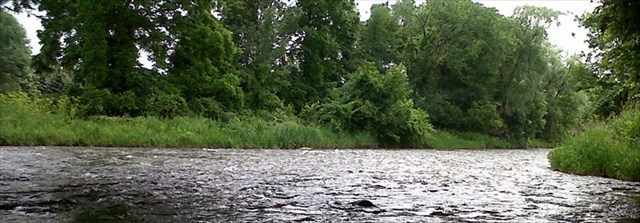Credit River - SS Sultana Traditional Cache
Credit River - SS Sultana
-
Difficulty:
-

-
Terrain:
-

Size:  (micro)
(micro)
Related Web Page
Please note Use of geocaching.com services is subject to the terms and conditions
in our disclaimer.
Credit River - Shipwreck Series
SS Sultana
April 27, 1865

There are many shipwrecks around the world. Some very famous and others not so. Each however has it’s own story to tell. As you travel along the Credit River doing this series of caches, we have highlighted a number of these shipwrecks. During low water levels on these parts of the Credit River, you need to be careful in a canoe or kayak so as you don’t wind up in your own shipwreck. Besides the many large rocks along the way, there are also some other obstacles such as dams which should be avoided. All of the geocaches in this series have been placed on foot by walking in the water along the credit river. Whichever way you choose to search for these caches, use caution and common sense.
More information about this series can be found here: Credit River - Shipwreck Series
SS Sultana
SS Sultana was a Mississippi River steamboat paddlewheeler that exploded on April 27, 1865 in the greatest maritime disaster in United States history. An estimated 1,600 of its 2,400 passengers died when three of the ship's four boilers exploded and it sank near Memphis. This disaster was overshadowed in the press by other recent events. John Wilkes Booth, President Lincoln's assassin, was killed the day before.
The wooden steamship was constructed in 1863 by the John Litherbury Shipyard in Cincinnati, and intended for the lower Mississippi cotton trade. Registering 1,719 tons, the steamer normally carried a crew of 85. For two years, it ran a regular route between St. Louis and New Orleans, frequently commissioned to carry troops.
Under the command of Captain J. C. Mason of St. Louis, the Sultana left New Orleans on April 21, 1865, with 75 to 100 cabin passengers, deck passengers, and numerous head of livestock bound for market in St. Louis. At Vicksburg, it stopped for a series of hasty repairs to the boilers and to take on more passengers. Rather than have a bad boiler replaced, a small patch repair was made to reinforce a leaking area. A section of bulged boiler plate was removed, and a patch of lesser thickness than the parent plate was riveted in its place. This repair took about one day, whereas a complete replacement of the boiler would have taken about three days. During its time in port, men tried to muscle, bribe, and threaten their way on board, until the ship was bursting at the seams with soldiers. More than 2,000 men crowded aboard.
Most of the new passengers were Union soldiers, chiefly from Ohio and just released from Confederate prison camps such as Cahawba and Andersonville. The US government had contracted with the Sultana to transport these former prisoners of war back to their homes. With a legal capacity of only 376, it was severely overcrowded. Many of the passengers had been weakened by their incarceration and associated illnesses. Passengers were packed into every available berth, and the overflow was so severe that the decks were completely packed.
The cause of the explosion was a leaky and poorly repaired steam boiler. There was reason to believe allowable working steam pressure was exceeded in an attempt to overcome the spring river current.[3] The boiler (or boilers) gave way when the steamer was 7 to 9 miles (11 to 14 km) north of Memphis at 2:00 am.[4] The enormous explosion flung some of the passengers on deck into the water, and destroyed a large section of the ship. Hot coals scattered by the explosion soon turned the remaining superstructure into an inferno, the glare of which was visible as far away as Memphis.
The first boat on the scene was the southbound steamer Bostonia II which arrived at about 3:00 am, an hour after the explosion, and overtook the burning wreck to rescue scores of survivors. The hulk drifted to the west bank of the river, and sank at around dawn near the tiny settlement of Mound City near present-day Marion, Arkansas. Other vessels joined the rescue, including the steamers Arkansas, Jenny Lind, Essex, and the Navy sidewheel gunboat USS Tyler, manned by volunteers. The ship's regular crew had been discharged days before. Passengers who survived the initial explosion had to risk their lives in the icy spring runoff of the Mississippi or burn with the ship. Many died of drowning or hypothermia. Some survivors were plucked from trees along the Arkansas shore. Bodies of victims continued to be found downriver for months, some as far as Vicksburg. Many bodies were never recovered. The Sultana's officers, including Captain Mason, were among those who perished. About 500 survivors, many with horrible burns, were transported to hospitals in Memphis. Up to 300 of them died later from burns or exposure. Newspaper accounts indicate that the people of Memphis had sympathy for the victims despite the fact that they had recently been enemies. The Chicago Opera Troupe staged a benefit, the crew of Essex raised $1,000, and the mayor took in three survivors. Monuments and historical markers to the Sultana and its victims have been erected at Memphis; Muncie, Indiana; Marion; Vicksburg; |Cincinnati; Knoxville; Hillsdale, Michigan; and Mansfield, Ohio.


Additional Hints
(Decrypt)
2 srrg nobir jngre va ebpx jnyy.